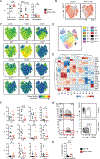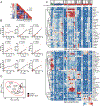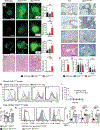Dysregulated IFN-γ signals promote autoimmunity in STAT1 gain-of-function syndrome
- PMID: 37406138
- PMCID: PMC11645977
- DOI: 10.1126/scitranslmed.ade7028
Dysregulated IFN-γ signals promote autoimmunity in STAT1 gain-of-function syndrome
Abstract
Heterozygous signal transducer and activator of transcription 1 (STAT1) gain-of-function (GOF) mutations promote a clinical syndrome of immune dysregulation characterized by recurrent infections and predisposition to humoral autoimmunity. To gain insights into immune characteristics of STAT1-driven inflammation, we performed deep immunophenotyping of pediatric patients with STAT1 GOF syndrome and age-matched controls. Affected individuals exhibited dysregulated CD4+ T cell and B cell activation, including expansion of TH1-skewed CXCR3+ populations that correlated with serum autoantibody titers. To dissect underlying immune mechanisms, we generated Stat1 GOF transgenic mice (Stat1GOF mice) and confirmed the development of spontaneous humoral autoimmunity that recapitulated the human phenotype. Despite clinical resemblance to human regulatory T cell (Treg) deficiency, Stat1GOF mice and humans with STAT1 GOF syndrome exhibited normal Treg development and function. In contrast, STAT1 GOF autoimmunity was characterized by adaptive immune activation driven by dysregulated STAT1-dependent signals downstream of the type 1 and type 2 interferon (IFN) receptors. However, in contrast to the prevailing type 1 IFN-centric model for STAT1 GOF autoimmunity, Stat1GOF mice lacking the type 1 IFN receptor were only partially protected from STAT1-driven systemic inflammation, whereas loss of type 2 IFN (IFN-γ) signals abrogated autoimmunity. Last, germline STAT1 GOF alleles are thought to enhance transcriptional activity by increasing total STAT1 protein, but the underlying biochemical mechanisms have not been defined. We showed that IFN-γ receptor deletion normalized total STAT1 expression across immune lineages, highlighting IFN-γ as the critical driver of feedforward STAT1 elevation in STAT1 GOF syndrome.
Conflict of interest statement
Competing interests:
The authors declare the following competing interests. D.L. is an advisor/consultant to the Cystic Fibrosis Foundation Therapeutics Inc., the University of Washington Institute for Translational Medicine Drug and Device Advisory Board, DNARx LLC., Athira Pharma Inc., Kymera Therapeutics Inc., and Sonomotion Inc. T.R.T has had consulting relationships with Takeda, CSL Behring, Grifols, Enzyvant, X4 Pharmaceuticals, Horizon, and Pharming Healthcare, and performed collaborative studies with Incyte and Eli Lilly. J.H.B. is a Scientific Co-Founder and Scientific Advisory Board member of GentiBio, a consultant for Bristol-Myers Squibb and Hotspot Therapeutics, and has past and current research projects sponsored by Amgen, Bristol-Myers Squib, Janssen, Novo Nordisk, and Pfizer. She is a member of the Type 1 Diabetes Trialnet Study Group, a partner of the Allen Institute for Immunology, and a member of the Scientific Advisory Boards for the La Jolla Institute for Allergy and Immunology and BMS Immunology. D.J.R. is Scientific Co-Founder, Scientific Advisor and Scientific Advisory Board member of GentiBio, and Scientific Co-Founder and Scientific Advisory Board member of BeBiopharma Inc. He has past and current funding from GentiBio, CSL-Behring, BeBiopharma Inc., and Emendo Bio for unrelated studies. S.W.J. previously is a consultant for ChemoCentryx, Inc. All other authors declare that they have no competing interests.
Figures








References
-
- Casanova JL, Abel L, Quintana-Murci L, Immunology taught by human genetics. Cold Spring Harb Symp Quant Biol 78, 157–172 (2013). - PubMed
-
- Liu L, Okada S, Kong XF, Kreins AY, Cypowyj S, Abhyankar A, Toubiana J, Itan Y, Audry M, Nitschke P, Masson C, Toth B, Flatot J, Migaud M, Chrabieh M, Kochetkov T, Bolze A, Borghesi A, Toulon A, Hiller J, Eyerich S, Eyerich K, Gulacsy V, Chernyshova L, Chernyshov V, Bondarenko A, Grimaldo RM, Blancas-Galicia L, Beas IM, Roesler J, Magdorf K, Engelhard D, Thumerelle C, Burgel PR, Hoernes M, Drexel B, Seger R, Kusuma T, Jansson AF, Sawalle-Belohradsky J, Belohradsky B, Jouanguy E, Bustamante J, Bue M, Karin N, Wildbaum G, Bodemer C, Lortholary O, Fischer A, Blanche S, Al-Muhsen S, Reichenbach J, Kobayashi M, Rosales FE, Lozano CT, Kilic SS, Oleastro M, Etzioni A, Traidl-Hoffmann C, Renner ED, Abel L, Picard C, Marodi L, Boisson-Dupuis S, Puel A, Casanova JL, Gain-of-function human STAT1 mutations impair IL-17 immunity and underlie chronic mucocutaneous candidiasis. The Journal of experimental medicine 208, 1635–1648 (2011). - PMC - PubMed
-
- van de Veerdonk FL, Plantinga TS, Hoischen A, Smeekens SP, Joosten LA, Gilissen C, Arts P, Rosentul DC, Carmichael AJ, Smits-van der Graaf CA, Kullberg BJ, van der Meer JW, Lilic D, Veltman JA, Netea MG, STAT1 mutations in autosomal dominant chronic mucocutaneous candidiasis. N Engl J Med 365, 54–61 (2011). - PubMed
-
- Uzel G, Sampaio EP, Lawrence MG, Hsu AP, Hackett M, Dorsey MJ, Noel RJ, Verbsky JW, Freeman AF, Janssen E, Bonilla FA, Pechacek J, Chandrasekaran P, Browne SK, Agharahimi A, Gharib AM, Mannurita SC, Yim JJ, Gambineri E, Torgerson T, Tran DQ, Milner JD, Holland SM, Dominant gain-of-function STAT1 mutations in FOXP3 wild-type immune dysregulation-polyendocrinopathy-enteropathy-X-linked-like syndrome. J Allergy Clin Immunol 131, 1611–1623 (2013). - PMC - PubMed
-
- Toubiana J, Okada S, Hiller J, Oleastro M, Lagos Gomez M, Aldave Becerra JC, Ouachee-Chardin M, Fouyssac F, Girisha KM, Etzioni A, Van Montfrans J, Camcioglu Y, Kerns LA, Belohradsky B, Blanche S, Bousfiha A, Rodriguez-Gallego C, Meyts I, Kisand K, Reichenbach J, Renner ED, Rosenzweig S, Grimbacher B, van de Veerdonk FL, Traidl-Hoffmann C, Picard C, Marodi L, Morio T, Kobayashi M, Lilic D, Milner JD, Holland S, Casanova JL, Puel A, S. G.-o.-F. S. G. International, Heterozygous STAT1 gain-of-function mutations underlie an unexpectedly broad clinical phenotype. Blood 127, 3154–3164 (2016). - PMC - PubMed
Publication types
MeSH terms
Substances
Grants and funding
LinkOut - more resources
Full Text Sources
Molecular Biology Databases
Research Materials
Miscellaneous

